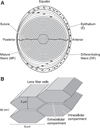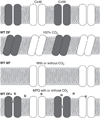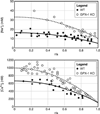Lens gap junctions in growth, differentiation, and homeostasis
- PMID: 20086076
- PMCID: PMC4627646
- DOI: 10.1152/physrev.00034.2009
Lens gap junctions in growth, differentiation, and homeostasis
Abstract
The cells of most mammalian organs are connected by groups of cell-to-cell channels called gap junctions. Gap junction channels are made from the connexin (Cx) family of proteins. There are at least 20 isoforms of connexins, and most tissues express more than 1 isoform. The lens is no exception, as it expresses three isoforms: Cx43, Cx46, and Cx50. A common role for all gap junctions, regardless of their Cx composition, is to provide a conduit for ion flow between cells, thus creating a syncytial tissue with regard to intracellular voltage and ion concentrations. Given this rather simple role of gap junctions, a persistent question has been: Why are there so many Cx isoforms and why do tissues express more than one isoform? Recent studies of lens Cx knockout (KO) and knock in (KI) lenses have begun to answer these questions. To understand these roles, one must first understand the physiological requirements of the lens. We therefore first review the development and structure of the lens, its numerous transport systems, how these systems are integrated to generate the lens circulation, the roles of the circulation in lens homeostasis, and finally the roles of lens connexins in growth, development, and the lens circulation.
Figures















Similar articles
-
Lens gap junctional coupling is modulated by connexin identity and the locus of gene expression.Invest Ophthalmol Vis Sci. 2004 Oct;45(10):3629-37. doi: 10.1167/iovs.04-0445. Invest Ophthalmol Vis Sci. 2004. PMID: 15452070
-
Knock-in of Cx46 partially rescues fiber defects in lenses lacking Cx50.Mol Vis. 2017 Mar 24;23:160-170. eCollection 2017. Mol Vis. 2017. PMID: 28458505 Free PMC article.
-
Optimal lens epithelial cell proliferation is dependent on the connexin isoform providing gap junctional coupling.Invest Ophthalmol Vis Sci. 2007 Dec;48(12):5630-7. doi: 10.1167/iovs.06-1540. Invest Ophthalmol Vis Sci. 2007. PMID: 18055813
-
Roles and regulation of lens epithelial cell connexins.FEBS Lett. 2014 Apr 17;588(8):1297-303. doi: 10.1016/j.febslet.2013.12.024. Epub 2014 Jan 14. FEBS Lett. 2014. PMID: 24434541 Free PMC article. Review.
-
Gap junctions or hemichannel-dependent and independent roles of connexins in cataractogenesis and lens development.Curr Mol Med. 2010 Dec;10(9):851-63. doi: 10.2174/156652410793937750. Curr Mol Med. 2010. PMID: 21091421 Free PMC article. Review.
Cited by
-
Longitudinal study of microphthalmia in connexin 50 knockout mice using spectral-domain optical coherence tomography.Front Ophthalmol (Lausanne). 2024 May 3;4:1387961. doi: 10.3389/fopht.2024.1387961. eCollection 2024. Front Ophthalmol (Lausanne). 2024. PMID: 38984115 Free PMC article.
-
Oxidative Stress and Cataract Formation: Evaluating the Efficacy of Antioxidant Therapies.Biomolecules. 2024 Aug 25;14(9):1055. doi: 10.3390/biom14091055. Biomolecules. 2024. PMID: 39334822 Free PMC article. Review.
-
MicroRNA-124 facilitates lens epithelial cell apoptosis by inhibiting SPRY2 and MMP-2.Mol Med Rep. 2021 May;23(5):381. doi: 10.3892/mmr.2021.12020. Epub 2021 Mar 24. Mol Med Rep. 2021. PMID: 33760112 Free PMC article.
-
Triarylmethanes, a new class of cx50 inhibitors.Front Pharmacol. 2012 Jun 6;3:106. doi: 10.3389/fphar.2012.00106. eCollection 2012. Front Pharmacol. 2012. PMID: 22685432 Free PMC article.
-
The effects of age on lens transport.Invest Ophthalmol Vis Sci. 2013 Nov 1;54(12):7174-87. doi: 10.1167/iovs.13-12593. Invest Ophthalmol Vis Sci. 2013. PMID: 24065810 Free PMC article.
References
-
- Addison PK, Berry V, Holden KR, Espinal D, Rivera B, Su H, Srivastava AK, Bhattacharya SS. A novel mutation in the connexin 46 gene (GJA3) causes autosomal dominant zonular pulverulent cataract in a Hispanic family. Mol Vis. 2006;12:791–795. - PubMed
-
- Al-Ghoul KJ, Kirk T, Kuszak AJ, Zoltoski RK, Shiels A, Kuszak JR. Lens structure in MIP-deficient mice. Anat Rec A Discov Mol Cell Evol Biol. 2003;273:714–730. - PubMed
-
- Alvarez LJ, Candia OA, Polikoff LA. Beta-adrenergic stimulation of Na(+)-K(+)-2Cl(−) cotransport activity in the rabbit lens. Exp Eye Res. 2003;76:61–70. - PubMed
-
- Alvarez LJ, Candia OA, Turner HC, Polikoff LA. Localization of a Na(+)-K(+)-2Cl(−) cotransporter in the rabbit lens. Exp Eye Res. 2001;73:669–680. - PubMed
-
- Alvarez LJ, Candia OA, Wolosin JM. Evidence for parallel Na(+)-H(+) and Na(+)-dependent Cl(−)-HCO3(−) exchangers in cultured bovine lens cells. Exp Eye Res. 1992;55:747–755. - PubMed
Publication types
MeSH terms
Substances
Grants and funding
LinkOut - more resources
Full Text Sources
Other Literature Sources
Research Materials
Miscellaneous

